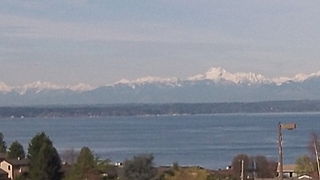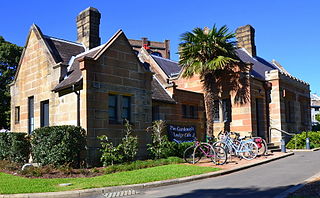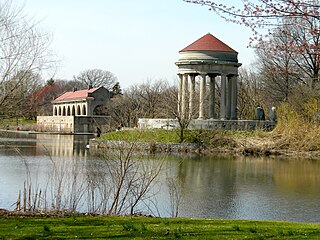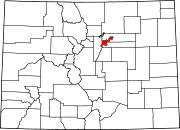
Radburn is an unincorporated community located within the borough of Fair Lawn in Bergen County, in the U.S. state of New Jersey.

Prospect Park is an urban park in Brooklyn, New York City. The park is situated between the neighborhoods of Park Slope, Prospect Heights, Prospect Lefferts Gardens, Flatbush, and Windsor Terrace, and is adjacent to the Brooklyn Museum, Grand Army Plaza, and the Brooklyn Botanic Garden. With an area of 526 acres (213 ha), Prospect Park is the second largest public park in Brooklyn, behind Marine Park. Designated as a New York City scenic landmark and listed on the National Register of Historic Places, Prospect Park is operated by the Prospect Park Alliance and NYC Parks.

Jackson Park is a 551.5-acre (223.2 ha) park located on the South Side of Chicago, Illinois. It was designed in 1871 by Frederick Law Olmsted and Calvert Vaux, then greatly remodeled in 1893 to serve as the site of the World's Columbian Exposition, making it one of the largest and most historically significant parks in the city. Some features attest to the legacy of the fair, including a Japanese garden, the Statue of TheRepublic, and the Museum of Science and Industry. As part of the Woodlawn community area, it extends along Lake Michigan and also borders the neighborhoods of Hyde Park and South Shore.

Volunteer Park is a 48.3-acre (19.5 ha) park in the Capitol Hill neighborhood of Seattle, Washington, United States.

Broadview is a neighborhood in northwestern Seattle, Washington, United States.

Victoria Park is a 9-hectare (22-acre) urban park situated on the corner of Parramatta Road and City Road, Camperdown, in the City of Sydney, New South Wales, Australia. The park is located adjacent to The University of Sydney and the Broadway Shopping Centre.

The Back Bay Fens, often called The Fens, is a parkland and urban wild in Boston, Massachusetts, in the United States. It was established in 1879. Designed by Frederick Law Olmsted to serve as a link in the Emerald Necklace park system, the Fens gives its name to the Fenway-Kenmore neighborhood.

Parks in Chicago include open spaces and facilities, developed and managed by the Chicago Park District. The City of Chicago devotes 8.5% of its total land acreage to parkland, which ranked it 13th among high-density population cities in the United States in 2012. Since the 1830s, the official motto of Chicago has been Urbs in horto, Latin for "City in a garden" for its commitment to parkland. In addition to serving residents, a number of these parks also double as tourist destinations, most notably Lincoln Park, Chicago's largest park, visited by over 20 million people each year, is one of the most visited parks in the United States. Notable architects, artists and landscape architects have contributed to the 570 parks, including Daniel Burnham, Frederick Law Olmsted, Jens Jensen, Dwight Perkins, Frank Gehry, and Lorado Taft.

Druid Hill Park is a 745-acre (3.01 km2) urban park in northwest Baltimore, Maryland. Its boundaries are marked by Druid Park Drive (north), Swann Drive and Reisterstown Road, and the Jones Falls Expressway / Interstate 83 (east).

Birkenhead Park is a major public park located in the centre of Birkenhead, Merseyside, England. It was designed by Joseph Paxton and opened on 5 April 1847. It is generally acknowledged as the first publicly funded civic park in the world. The park was designated a conservation area in 1977 and declared a Grade I listed landscape by English Heritage in 1995. In 2023 the park was placed on the UK government's "tentative list" of applications for UNESCO World Heritage Site status. The park influenced the design of Central Park in New York and Sefton Park in Liverpool.
Cloverdale is a neighborhood within the American city of Montgomery, Alabama. It is the largest garden-landscaped neighborhood in the state of Alabama. Built in the late nineteenth and early twentieth centuries, it is one of Montgomery's "genteel" areas. The term serves two purposes: the "original" Cloverdale area, and the larger area, which includes other historic neighborhoods such as Cloverdale-Idlewild.

City Park is an urban park and neighborhood in Denver, Colorado. The park is 330 acres (1.3 km2) and is located in east-central Denver. The park contains the Denver Zoo, the Denver Museum of Nature and Science, Ferril and Duck Lakes, and a boathouse. City Park is also the name of the neighborhood that contains the park, though the park is the vast majority of the neighborhood. To the immediate north of the park is the City Park Golf Course. City Park is the largest park in Denver.

Conservatory Water is a pond located in a natural hollow within Central Park in Manhattan, New York City. It is located west of Fifth Avenue, centered opposite East 74th Street. The pond is surrounded by several landscaped hills, including Pilgrim Hill dotted by groves of Yoshino cherry trees and Pug Hill, resulting in a somewhat manicured park landscape, planned in deferential reference to the estate plantings of the owners of the mansions that once lined the adjacent stretch of Fifth Avenue.

Franklin Delano Roosevelt (FDR) Park is a park located along the Delaware River in the southernmost point of South Philadelphia, Pennsylvania, United States, comprising some 348 acres (1.41 km2) which includes a 146-acre (0.59 km2) golf course, about 125 acres (0.51 km2) of buildings, roadways, pathways for walking, landscaped architecture, and a variety of picnic and recreation areas placed within about 77 acres (310,000 m2) of natural lands including ponds and lagoons.

Cheesman Park is an urban park and neighborhood located in the City and County of Denver, Colorado, United States.

Villa Park is a neighborhood in the city of Denver, Colorado. Its hilly topography provides panoramic views of downtown Denver and of the Rocky Mountains, particularly from Lakewood / Dry Gulch Park, which divides the neighborhood diagonally.

Congress Park is a park and a neighborhood in the City and County of Denver, Colorado, United States. In 2010, the neighborhood had 10,235 residents and 5,724 households.

Park 12, is one of the 29 Parks that make up the Adelaide Park Lands. It consists of 55.5 hectares bounded by North Terrace, Frome Road, Sir Edwin Smith Avenue and King William Road

Spokane and its neighborhoods contain a patchwork of architectural styles that give them a distinct identity and illustrate the changes throughout the city's history. Spokane has a rich architectural history for a western city of its size and much of it is a product of its circumstances at the turn of the 20th century when as a rapidly growing city, the Great Fire of 1889 destroyed 32 blocks of the city center which was quickly rebuilt in a more grand fashion by a community flush with money coming from regional mining districts. Many of the architects that found work in the city and building on the blank slate of the downtown commercial district became highly esteemed architects such as Kirtland Cutter, who has been credited with giving the city a distinctive character. In particular, the city has a high concentration of Romanesque Revival style institutional and commercial buildings and American Craftsman bungalow residences. The architecture of Spokane gained national recognition in industry publications in the early 20th century.

Liberty Park is a 22 acres (8.9 ha) public park at Third Ave and Perry St in East Central, Spokane, Washington. It is open daily with entry gratis.
























